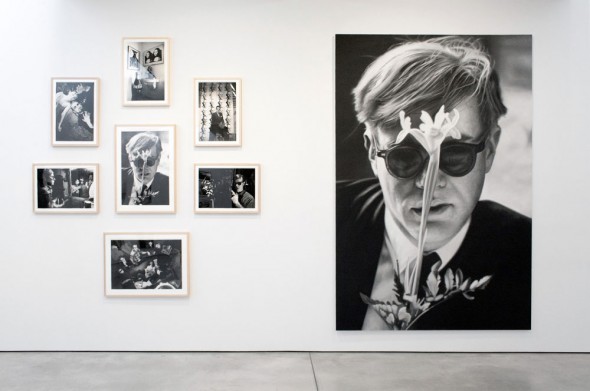
Dennis Hopper Signs of the Times Tony Shafrazi Gallery, New York, September 12–October 24, 2009
Dennis Hopper didn’t just create memorable roles; he defined entire epochs. Hopper, a cool cat with some nine lives—actor, filmmaker, photographer, painter, sculptor, drug-fueled maniac and redeemed man—died on May 29, 2010, at the age of 74, leaving behind a body of work that will far outlast him.
Hopper’s 1969 directorial debut Easy Rider, and his portrayal of a cocaine-smuggling longhaired hippie, encapsulated the dreams and nightmares of the counter-culture. While celebrating the psychedelic soul-searching road-trip—scored to Steppenwolf’s “Born to Be Wild”—the film comes down off its LSD high with a bruising reality check about the failures of the free-love movement—immortalized in that unforgettable line, “We blew it.”
Sixteen years later, in David Lynch’s Blue Velvet, Hopper’s foul-mouthed, bolo tie-wearing psycho Frank Booth (“Heineken, Fuck that shit. Pabst Blue Ribbon!”) stands in for the violent madness lying beneath the surface of complacent, conservative 1980s America. In Booth—voted among cinema’s top 50 villains of all time by the American Film Institute—Hopper exorcised some 20 years of drug and alcohol abuse to create a gas-inhaling wildman, both infantile and monstrous (“Baby wants to fuck!” he yells to Isabella Rossellini’s nightclub singer in the film’s most infamous scene).
While F. Scott Fitzgerald wrote there are no second acts in American lives, Hopper had many. When the former farm boy, frail as a result of prostate cancer, received his star on the Hollywood Walk of Fame in March 2010, fan and fellow actor Viggo Mortensen summarized the actor’s startling endurance, “He is someone who has seemed to regularly rise out of the ashes of self-inflicted chaos, surprising us with his originality and wit as an artist, and defying the odds by somehow staying alive physically and professionally.”
Hopper started acting at the age of 16, when he left home to join LA’s Pasadena Playhouse. (He went on to perform in more than 200 roles in television and film.) A student of conventional Hollywood acting in the late 1940s, Hopper experienced his first epiphany at the age of 14 when he first saw Marlon Brando in Viva Zapata and Montgomery Clift in A Place in the Sun. “In one week, my whole thinking on acting changed,” Hopper recalled during an episode of Inside the Actors Studio. For the first time, he saw on screen “people who were really thinking, feeling, doing things,” he explained. “There was something real happening. I didn’t know what it was, but I knew it was fantastic and I had to find that thing.”
Hopper’s quest soon led him to Method pioneer, James Dean—they acted together in the wayward teen classic Rebel Without a Cause and the epic Texas melodrama Giant. “Don’t presuppose anything,’ that’s what he told me and that’s where I started,” Hopper said. After refusing to take orders from director Henry Hathaway on a movie called From Hell to Texas in 1958, Hopper was essentially blackballed from working in Hollywood for eight years. By the time he got back in, the 1960s were in full swing and the studio system was in freefall. Rule-breaking, socially relevant movies like The Graduate and Bonnie and Clyde shook up the movie industry, carving out a path for a groundbreaking youth-centered cinema. And Hopper wanted to join the New Hollywood revolution.
“I was hellbent to make a movie,” he told The Guardian newspaper in 2001. “I didn’t give a fuck if I ran over people in the street: if they got in the way, then they’d better get out of the way that was my objective and that’s what I did.” Easy Rider, though you’d never believe it if you saw it today, with its elliptical narrative, avant-garde editing and gritty shooting style, became a box-office blockbuster.
Success didn’t exactly spoil Dennis Hopper, but a sense of rot festered during the subsequent years. He was drinking – half a gallon of rum and dozens of beersand then sobering up with lines of cocaine. “It was all like part of the creative process to me,” he explained to The Guardian. But then, as with the disillusionment of Easy Rider, it all went to Hell. “We were all going to hold hands, take LSD, find God and what happened? We ended up at the drug dealer’s door, carrying guns and in total madness,” he once said.
Stories of Hopper’s drug-fueled madness are legendary—trying to climb out of a plane’s emergency exit, firing a machine gun into the walls of his house. Such colorful anecdotes may help construct a portrait of a man who is most remembered for embodying wackos, whether it be Frank Booth or Apocalypse Now’s stoned photographer. But Hopper’s longstanding, disparate career, spanning five decades and countless cultural shifts, transcends such narrow characterizations. After going clean in the 1980s, he received an Oscar nomination for 1986’s Hoosiers, and two years later, returned to the director’s chair for the acclaimed Los Angeles gang drama Colors. His maniacal bomber in 1994’s Speed delivered Hopper’s fan base another dose of high-spirited lunacy, but by then, such characterizations were more kitschy throwbacks to a bygone era. Writing in the Los Angeles Times, would-be Hopper biographer Richard Stayton described these comeback years as carefully orchestrated, calling him “a serious careerist calculating his return from illegality and literal madness, tenaciously managing his sobriety.”
More than the sum of his parts, Hopper, photographer and painter, “intoxicating and toxic”—in Stayton’s words—evolved then from counterculture rebel to consummate artist, celebrated around the world in solo shows, from Amsterdam to Los Angeles (where this summer’s comprehensive MOCA exhibit was planned long before Hopper’s death). But whether acting, directing or photographing, Hopper made it clear, in an interview in 2001, what ultimately drove it all. “The only reason you go into art,” he said, “is that you hope you can cheat death a little by leaving something that’s going to last a little bit beyond your own time.”
– Anthony Kaufman

